句式结构 祈使句倒装句强调句四there be 结构
文档属性
| 名称 | 句式结构 祈使句倒装句强调句四there be 结构 |  | |
| 格式 | rar | ||
| 文件大小 | 17.5KB | ||
| 资源类型 | 教案 | ||
| 版本资源 | 人教版(新课程标准) | ||
| 科目 | 英语 | ||
| 更新时间 | 2011-09-22 09:44:47 | ||
图片预览

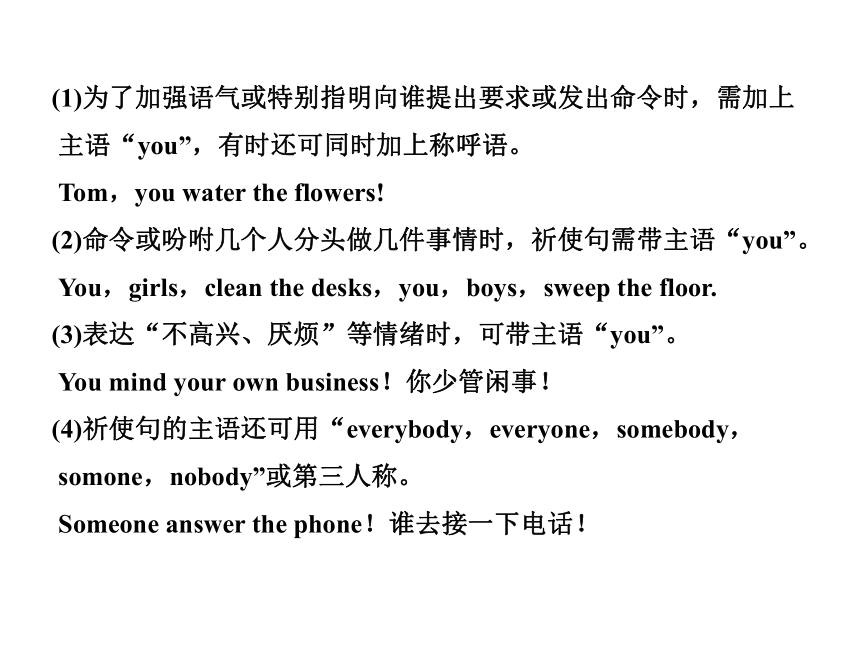
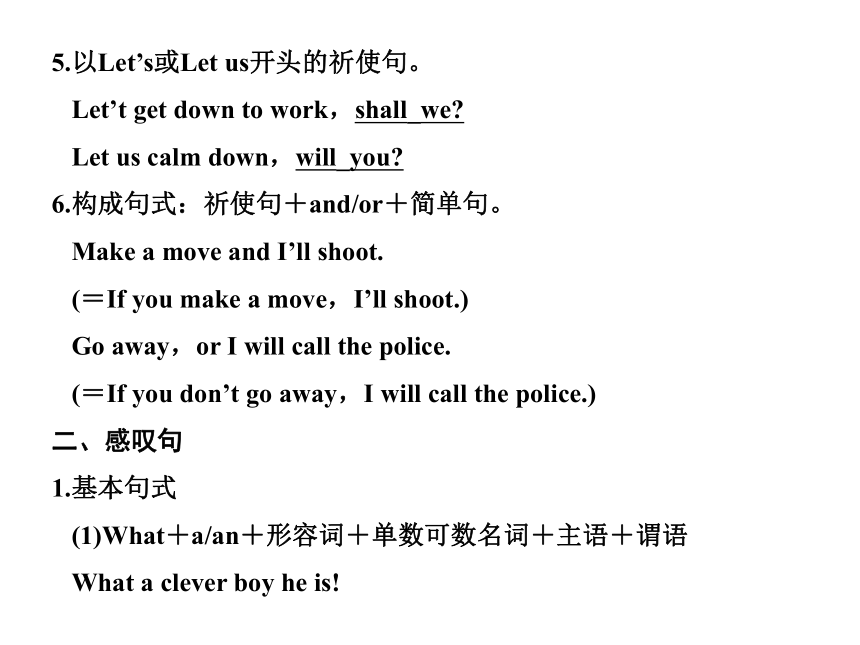
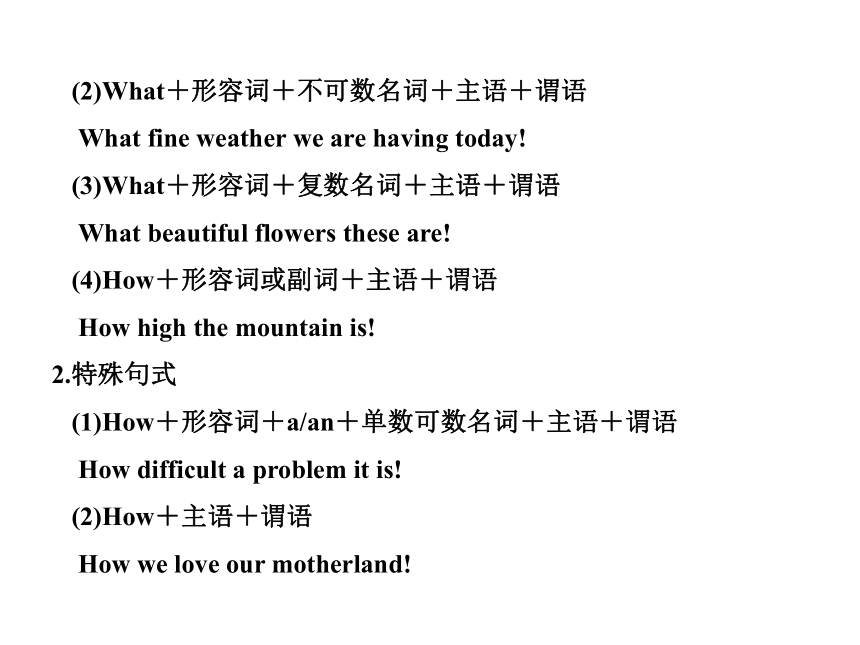
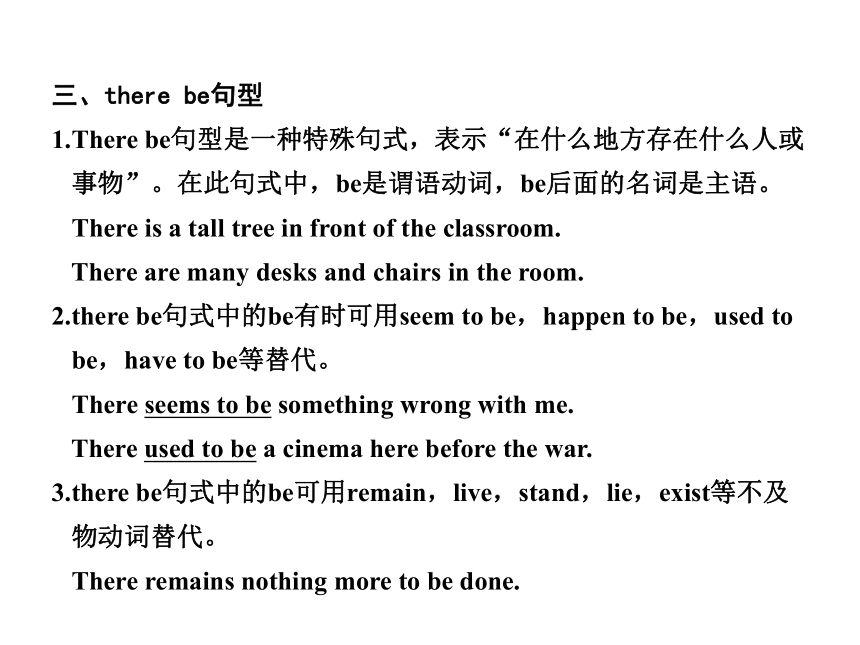
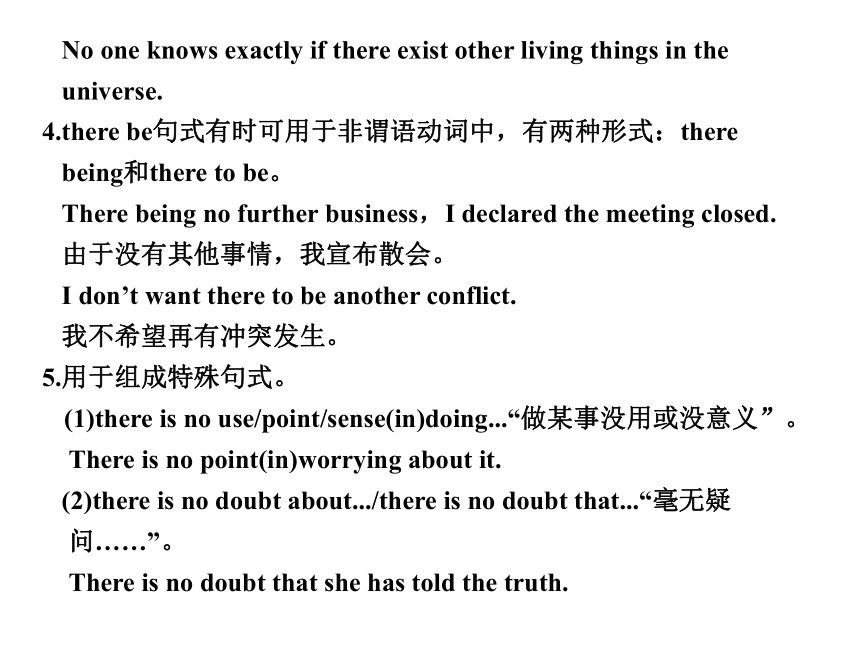
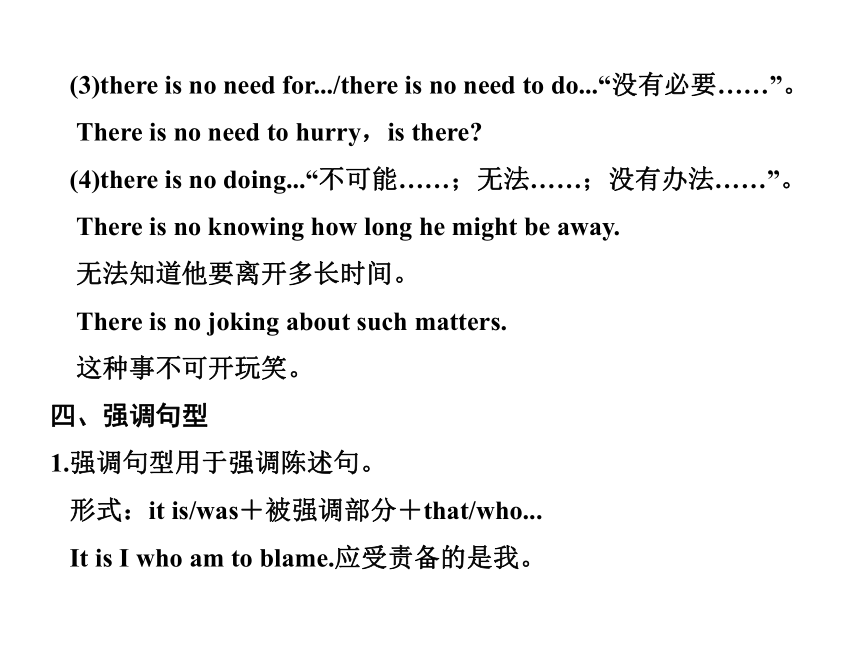

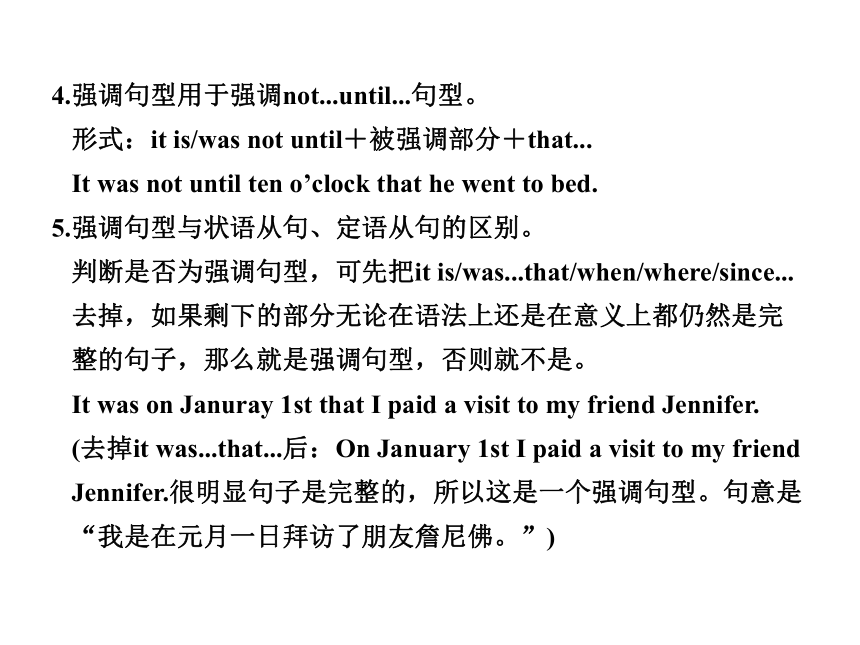
文档简介
(共22张PPT)
(十三)句式结构
一、祈使句
1.祈使句的否定式是在句首原形动词前加don’t或never。
Please don’t forget to take your medicine.
2.祈使句的反义疑问句是在句末加“will you?”。
Have another piece of cake,will you
Don’t make any noise,will you
3.祈使句前加助动词do用来加强语气。
Do turn off the light before you leave.
4.祈使句可以带主语。
(1)为了加强语气或特别指明向谁提出要求或发出命令时,需加上
主语“you”,有时还可同时加上称呼语。
Tom,you water the flowers!
(2)命令或吩咐几个人分头做几件事情时,祈使句需带主语“you”。
You,girls,clean the desks,you,boys,sweep the floor.
(3)表达“不高兴、厌烦”等情绪时,可带主语“you”。
You mind your own business!你少管闲事!
(4)祈使句的主语还可用“everybody,everyone,somebody,
somone,nobody”或第三人称。
Someone answer the phone!谁去接一下电话!
5.以Let’s或Let us开头的祈使句。
Let’t get down to work,shall_we
Let us calm down,will_you
6.构成句式:祈使句+and/or+简单句。
Make a move and I’ll shoot.
(=If you make a move,I’ll shoot.)
Go away,or I will call the police.
(=If you don’t go away,I will call the police.)
二、感叹句
1.基本句式
(1)What+a/an+形容词+单数可数名词+主语+谓语
What a clever boy he is!
(2)What+形容词+不可数名词+主语+谓语
What fine weather we are having today!
(3)What+形容词+复数名词+主语+谓语
What beautiful flowers these are!
(4)How+形容词或副词+主语+谓语
How high the mountain is!
2.特殊句式
(1)How+形容词+a/an+单数可数名词+主语+谓语
How difficult a problem it is!
(2)How+主语+谓语
How we love our motherland!
三、there be句型
1.There be句型是一种特殊句式,表示“在什么地方存在什么人或
事物”。在此句式中,be是谓语动词,be后面的名词是主语。
There is a tall tree in front of the classroom.
There are many desks and chairs in the room.
2.there be句式中的be有时可用seem to be,happen to be,used to
be,have to be等替代。
There seems to be something wrong with me.
There used to be a cinema here before the war.
3.there be句式中的be可用remain,live,stand,lie,exist等不及
物动词替代。
There remains nothing more to be done.
No one knows exactly if there exist other living things in the
universe.
4.there be句式有时可用于非谓语动词中,有两种形式:there
being和there to be。
There being no further business,I declared the meeting closed.
由于没有其他事情,我宣布散会。
I don’t want there to be another conflict.
我不希望再有冲突发生。
5.用于组成特殊句式。
(1)there is no use/point/sense(in)doing...“做某事没用或没意义”。
There is no point(in)worrying about it.
(2)there is no doubt about.../there is no doubt that...“毫无疑
问……”。
There is no doubt that she has told the truth.
(3)there is no need for.../there is no need to do...“没有必要……”。
There is no need to hurry,is there
(4)there is no doing...“不可能……;无法……;没有办法……”。
There is no knowing how long he might be away.
无法知道他要离开多长时间。
There is no joking about such matters.
这种事不可开玩笑。
四、强调句型
1.强调句型用于强调陈述句。
形式:it is/was+被强调部分+that/who...
It is I who am to blame.应受责备的是我。
2.强调句型用于强调一般疑问句。
形式:is/was it+被强调部分+that/who...
Was it in 1896 that the modern Olympic Games started
此时,还可以把强调句型用于宾语从句中,但要注意语序的变
化。
I wonder if it is Professor Wang that teaches you English.
3.强调句型用于强调特殊疑问句。
形式:疑问词+is/was it that...
Who was it that broke the window
打破窗子的是谁?
此时,强调句型亦可用于宾语从句中,但要注意语序的变化。
I don’t understand why it is that smoking is not allowed here.
4.强调句型用于强调not...until...句型。
形式:it is/was not until+被强调部分+that...
It was not until ten o’clock that he went to bed.
5.强调句型与状语从句、定语从句的区别。
判断是否为强调句型,可先把it is/was...that/when/where/since...
去掉,如果剩下的部分无论在语法上还是在意义上都仍然是完
整的句子,那么就是强调句型,否则就不是。
It was on Januray 1st that I paid a visit to my friend Jennifer.
(去掉it was...that...后:On January 1st I paid a visit to my friend
Jennifer.很明显句子是完整的,所以这是一个强调句型。句意是
“我是在元月一日拜访了朋友詹尼佛。”)
It was January 1st when I paid a visit to my friend Jennifer.
(去掉it was...when...后:January 1st I paid a visit to my friend
Jennifer.显然句子不完整,所以这不是一个强调句型,而是一
个带有时间状语从句的复合句。句意是“那天是元月一日,我去
拜访了朋友詹尼佛。”)
五、倒装句
1.全部倒装
下列情况下,句子要使用全部倒装
(1)表示方位的副词(如up,down,out,in,away,round,
here,there)放在句首,句子的谓语动词是表示运动的不及物动
物(如go,come,run,rush,fly),主语是名词(注:不能是代
词)。
Here comes the train to Beijing.
但主语如果是人称代词,则句子不用倒装,主语仍置于动词之前。
The door opened and in she came.
【注】在全部倒装句中,谓语动词通常用一般现在时或一般过去
时,不能用进行时、将来时或完成时态。
(2)表示时间的副词now,then放在句首,句子的谓语动词是
come,主语是名词(注:不能是代词)。
Now comes your turn.
(3)介词短语放在句首作状语,句子的谓语动词是不及物动词(如
lie,stand,sit,exist,stretch,come)或系动词be,主语是名词
(注:不能是代词)。
After the banquet came a firework display in the garden.
(4)代词such放在句首,句子的谓语动词是be。
Such are the facts;no one can deny them.
(5)分词短语放在句首,句子的谓语动词是be,主语是名词。
Lying on the floor was a boy aged about 17.
2.部分倒装
下列情况下,句子要使用部分倒装:
(1)“only+副词、介词短语或从句”放在句首时。
Only when the war was over in 1918 was he able to get happily
back to work.
(2)含有否定意义的副词(如never,seldom,little,nowhere,
hardly等)放在句首时。
Never in history has technology made such rapid progress.
(3)“not a+n.”“not a single+n.”“not once”或“not until...”等短语放
在句首时。
Not a word did he say at the last meeting.
(4)表示否定意义的介词短语(如at no time,on no account,under
no circumstances,by no means,in no way等)放在句首时。
Under no circumstances could I agree to such a principle.
(5)在hardly...when...,no sooner...than...,not only...but also...引导
两个分句时,如把hardly,no sooner或not only放在句首,前一
个分句中的主谓要用部分倒装,后一个分句中则不用倒装。
Hardly had he begun to speak when his father stopped him.
(6)在“so+助动词+主语”和“neither/nor+助动词+主语”中。
They love having lots of friends;so do those with disabilities.
I don’t know,nor do I care.
(7)在“so+adj./adv.+that...”句式中,如将“so+adj./adv.”放在句首
时。
So moved was she that she could not say a word.
So loudly did he speak that even the people in the next room could
hear him.
(8)当if引导的虚拟条件从句中含有助动词had,were或should时,
如将if省略,则要将had,were或should等移到主语前。
Had it not been for your support,I would not have succeeded.
Should it rain tomorrow,we would put off the sports meet.
过关落实
1.—It’s a long time since I saw my sister.
—________ her this weekend
A.Why not visit B.Why not to visit
C.Why not visiting D.Why don’t visit
解析:“why not do...”means“why don’t you do...”用来提出
建议“为何不……”。
答案:A
2.—My room gets very cold at night.
—________.
A.So is mine B.So mine is
C.So does mine D.So mine does
解析:“so+助动词+主语”表示前面出现的情况同样适用于后
者。
答案:C
3.I don’t mind her criticizing me,but ______ is how she does it
that I object to.
A.it B.that C.this D.which
解析:强调句型中只能用it。
答案:A
4.You have failed two tests.You’d better start working harder,
________ you won’t pass the course.
A.and B.so C.but D.or
解析:并列连词or译为“否则”。
答案:D
5.When you’ve finished with that book,don’t forget to put it back
on the shelf,________?
A.do you B.don’t you C.will you D.won’t you
解析:否定祈使句的反意疑问句应用“will you?”。
答案:C
6.Help others whenever you can ________ you will make the world
a nicer place to live in.
A.and B.or C.unless D.but
解析:祈使句+and+简单句。
答案:A
7.—Jack bought a new mobile phone the other day.
—________? That’s his third one in just one month.
A.Had he B.Did he C.Does he D.Has he
解析:由上下文可知,应用一般过去时。
答案:B
8.—You should apologize to her,Barry.
—________,but it’s not going to be easy.
A.I suppose so B.I feel so
C.I prefer to D.I like to
解析:“我也这么认为。”是简略答语。
答案:A
9.Reality is not the way you wish things to be,nor the way they
appear to be,________ the way they actually are.
A.as B.or C.but D.and
解析:“not...nor...but...”表示“不是……,也不是……,而
是……”。
答案:C
10.The little boy came riding with full speed down the motorway on
his bicycle.________ it was!
A.What a dangerous scene B.What dangerous a scene
C.How a dangerous scene D.How dangerous the scene
解析:感叹句what+a/an+adj.+单数可数名词+主语+谓语。
答案:A
11.David said that it was because of his strong interest in literature
________ he chose the course.
A.that B.what C.why D.how
解析:此句包括了it was+被强调的原因状语+that句型结构。
答案:A
12.So difficult ________ it to work out the problem that I decided
to ask Tom for advice.
A.I did find B.did I find
C.I have found D.have I found
解析:本句中so+difficult(adj.)位于句首,前一分句要用
部分倒装。
答案:B
13.—Did Linda see the traffic accident
—No,no sooner ________ than it happened.
A.had she gone B.she had gone
C.has she gone D.she has gone
解析:no sooner...than...引导两个分句时,no sooner 位于
句首,前一分句要用部分倒装。
答案:A
14.I’ve tried very hard to improve my English.But by no means
________ with my progress.
A.the teacher is not satisfied
B.is the teacher not satisfied
C.the teacher is satisfied
D.is the teacher satisfied
解析:表示否定意义的介词短语(by no means)位于句子的句
首,所以用倒装形式且句中不能再出现not。
答案:D
15.Just in front of our house ________ with a history of 1,000 years.
A.does a tall tree stand B.stands a tall tree
C.a tall tree is standing D.a tall tree stands
解析:in front of our house介词短语放在句首,stand为不
及物动词,a tall tree作主语,全部倒装。
答案:B
(十三)句式结构
一、祈使句
1.祈使句的否定式是在句首原形动词前加don’t或never。
Please don’t forget to take your medicine.
2.祈使句的反义疑问句是在句末加“will you?”。
Have another piece of cake,will you
Don’t make any noise,will you
3.祈使句前加助动词do用来加强语气。
Do turn off the light before you leave.
4.祈使句可以带主语。
(1)为了加强语气或特别指明向谁提出要求或发出命令时,需加上
主语“you”,有时还可同时加上称呼语。
Tom,you water the flowers!
(2)命令或吩咐几个人分头做几件事情时,祈使句需带主语“you”。
You,girls,clean the desks,you,boys,sweep the floor.
(3)表达“不高兴、厌烦”等情绪时,可带主语“you”。
You mind your own business!你少管闲事!
(4)祈使句的主语还可用“everybody,everyone,somebody,
somone,nobody”或第三人称。
Someone answer the phone!谁去接一下电话!
5.以Let’s或Let us开头的祈使句。
Let’t get down to work,shall_we
Let us calm down,will_you
6.构成句式:祈使句+and/or+简单句。
Make a move and I’ll shoot.
(=If you make a move,I’ll shoot.)
Go away,or I will call the police.
(=If you don’t go away,I will call the police.)
二、感叹句
1.基本句式
(1)What+a/an+形容词+单数可数名词+主语+谓语
What a clever boy he is!
(2)What+形容词+不可数名词+主语+谓语
What fine weather we are having today!
(3)What+形容词+复数名词+主语+谓语
What beautiful flowers these are!
(4)How+形容词或副词+主语+谓语
How high the mountain is!
2.特殊句式
(1)How+形容词+a/an+单数可数名词+主语+谓语
How difficult a problem it is!
(2)How+主语+谓语
How we love our motherland!
三、there be句型
1.There be句型是一种特殊句式,表示“在什么地方存在什么人或
事物”。在此句式中,be是谓语动词,be后面的名词是主语。
There is a tall tree in front of the classroom.
There are many desks and chairs in the room.
2.there be句式中的be有时可用seem to be,happen to be,used to
be,have to be等替代。
There seems to be something wrong with me.
There used to be a cinema here before the war.
3.there be句式中的be可用remain,live,stand,lie,exist等不及
物动词替代。
There remains nothing more to be done.
No one knows exactly if there exist other living things in the
universe.
4.there be句式有时可用于非谓语动词中,有两种形式:there
being和there to be。
There being no further business,I declared the meeting closed.
由于没有其他事情,我宣布散会。
I don’t want there to be another conflict.
我不希望再有冲突发生。
5.用于组成特殊句式。
(1)there is no use/point/sense(in)doing...“做某事没用或没意义”。
There is no point(in)worrying about it.
(2)there is no doubt about.../there is no doubt that...“毫无疑
问……”。
There is no doubt that she has told the truth.
(3)there is no need for.../there is no need to do...“没有必要……”。
There is no need to hurry,is there
(4)there is no doing...“不可能……;无法……;没有办法……”。
There is no knowing how long he might be away.
无法知道他要离开多长时间。
There is no joking about such matters.
这种事不可开玩笑。
四、强调句型
1.强调句型用于强调陈述句。
形式:it is/was+被强调部分+that/who...
It is I who am to blame.应受责备的是我。
2.强调句型用于强调一般疑问句。
形式:is/was it+被强调部分+that/who...
Was it in 1896 that the modern Olympic Games started
此时,还可以把强调句型用于宾语从句中,但要注意语序的变
化。
I wonder if it is Professor Wang that teaches you English.
3.强调句型用于强调特殊疑问句。
形式:疑问词+is/was it that...
Who was it that broke the window
打破窗子的是谁?
此时,强调句型亦可用于宾语从句中,但要注意语序的变化。
I don’t understand why it is that smoking is not allowed here.
4.强调句型用于强调not...until...句型。
形式:it is/was not until+被强调部分+that...
It was not until ten o’clock that he went to bed.
5.强调句型与状语从句、定语从句的区别。
判断是否为强调句型,可先把it is/was...that/when/where/since...
去掉,如果剩下的部分无论在语法上还是在意义上都仍然是完
整的句子,那么就是强调句型,否则就不是。
It was on Januray 1st that I paid a visit to my friend Jennifer.
(去掉it was...that...后:On January 1st I paid a visit to my friend
Jennifer.很明显句子是完整的,所以这是一个强调句型。句意是
“我是在元月一日拜访了朋友詹尼佛。”)
It was January 1st when I paid a visit to my friend Jennifer.
(去掉it was...when...后:January 1st I paid a visit to my friend
Jennifer.显然句子不完整,所以这不是一个强调句型,而是一
个带有时间状语从句的复合句。句意是“那天是元月一日,我去
拜访了朋友詹尼佛。”)
五、倒装句
1.全部倒装
下列情况下,句子要使用全部倒装
(1)表示方位的副词(如up,down,out,in,away,round,
here,there)放在句首,句子的谓语动词是表示运动的不及物动
物(如go,come,run,rush,fly),主语是名词(注:不能是代
词)。
Here comes the train to Beijing.
但主语如果是人称代词,则句子不用倒装,主语仍置于动词之前。
The door opened and in she came.
【注】在全部倒装句中,谓语动词通常用一般现在时或一般过去
时,不能用进行时、将来时或完成时态。
(2)表示时间的副词now,then放在句首,句子的谓语动词是
come,主语是名词(注:不能是代词)。
Now comes your turn.
(3)介词短语放在句首作状语,句子的谓语动词是不及物动词(如
lie,stand,sit,exist,stretch,come)或系动词be,主语是名词
(注:不能是代词)。
After the banquet came a firework display in the garden.
(4)代词such放在句首,句子的谓语动词是be。
Such are the facts;no one can deny them.
(5)分词短语放在句首,句子的谓语动词是be,主语是名词。
Lying on the floor was a boy aged about 17.
2.部分倒装
下列情况下,句子要使用部分倒装:
(1)“only+副词、介词短语或从句”放在句首时。
Only when the war was over in 1918 was he able to get happily
back to work.
(2)含有否定意义的副词(如never,seldom,little,nowhere,
hardly等)放在句首时。
Never in history has technology made such rapid progress.
(3)“not a+n.”“not a single+n.”“not once”或“not until...”等短语放
在句首时。
Not a word did he say at the last meeting.
(4)表示否定意义的介词短语(如at no time,on no account,under
no circumstances,by no means,in no way等)放在句首时。
Under no circumstances could I agree to such a principle.
(5)在hardly...when...,no sooner...than...,not only...but also...引导
两个分句时,如把hardly,no sooner或not only放在句首,前一
个分句中的主谓要用部分倒装,后一个分句中则不用倒装。
Hardly had he begun to speak when his father stopped him.
(6)在“so+助动词+主语”和“neither/nor+助动词+主语”中。
They love having lots of friends;so do those with disabilities.
I don’t know,nor do I care.
(7)在“so+adj./adv.+that...”句式中,如将“so+adj./adv.”放在句首
时。
So moved was she that she could not say a word.
So loudly did he speak that even the people in the next room could
hear him.
(8)当if引导的虚拟条件从句中含有助动词had,were或should时,
如将if省略,则要将had,were或should等移到主语前。
Had it not been for your support,I would not have succeeded.
Should it rain tomorrow,we would put off the sports meet.
过关落实
1.—It’s a long time since I saw my sister.
—________ her this weekend
A.Why not visit B.Why not to visit
C.Why not visiting D.Why don’t visit
解析:“why not do...”means“why don’t you do...”用来提出
建议“为何不……”。
答案:A
2.—My room gets very cold at night.
—________.
A.So is mine B.So mine is
C.So does mine D.So mine does
解析:“so+助动词+主语”表示前面出现的情况同样适用于后
者。
答案:C
3.I don’t mind her criticizing me,but ______ is how she does it
that I object to.
A.it B.that C.this D.which
解析:强调句型中只能用it。
答案:A
4.You have failed two tests.You’d better start working harder,
________ you won’t pass the course.
A.and B.so C.but D.or
解析:并列连词or译为“否则”。
答案:D
5.When you’ve finished with that book,don’t forget to put it back
on the shelf,________?
A.do you B.don’t you C.will you D.won’t you
解析:否定祈使句的反意疑问句应用“will you?”。
答案:C
6.Help others whenever you can ________ you will make the world
a nicer place to live in.
A.and B.or C.unless D.but
解析:祈使句+and+简单句。
答案:A
7.—Jack bought a new mobile phone the other day.
—________? That’s his third one in just one month.
A.Had he B.Did he C.Does he D.Has he
解析:由上下文可知,应用一般过去时。
答案:B
8.—You should apologize to her,Barry.
—________,but it’s not going to be easy.
A.I suppose so B.I feel so
C.I prefer to D.I like to
解析:“我也这么认为。”是简略答语。
答案:A
9.Reality is not the way you wish things to be,nor the way they
appear to be,________ the way they actually are.
A.as B.or C.but D.and
解析:“not...nor...but...”表示“不是……,也不是……,而
是……”。
答案:C
10.The little boy came riding with full speed down the motorway on
his bicycle.________ it was!
A.What a dangerous scene B.What dangerous a scene
C.How a dangerous scene D.How dangerous the scene
解析:感叹句what+a/an+adj.+单数可数名词+主语+谓语。
答案:A
11.David said that it was because of his strong interest in literature
________ he chose the course.
A.that B.what C.why D.how
解析:此句包括了it was+被强调的原因状语+that句型结构。
答案:A
12.So difficult ________ it to work out the problem that I decided
to ask Tom for advice.
A.I did find B.did I find
C.I have found D.have I found
解析:本句中so+difficult(adj.)位于句首,前一分句要用
部分倒装。
答案:B
13.—Did Linda see the traffic accident
—No,no sooner ________ than it happened.
A.had she gone B.she had gone
C.has she gone D.she has gone
解析:no sooner...than...引导两个分句时,no sooner 位于
句首,前一分句要用部分倒装。
答案:A
14.I’ve tried very hard to improve my English.But by no means
________ with my progress.
A.the teacher is not satisfied
B.is the teacher not satisfied
C.the teacher is satisfied
D.is the teacher satisfied
解析:表示否定意义的介词短语(by no means)位于句子的句
首,所以用倒装形式且句中不能再出现not。
答案:D
15.Just in front of our house ________ with a history of 1,000 years.
A.does a tall tree stand B.stands a tall tree
C.a tall tree is standing D.a tall tree stands
解析:in front of our house介词短语放在句首,stand为不
及物动词,a tall tree作主语,全部倒装。
答案:B
